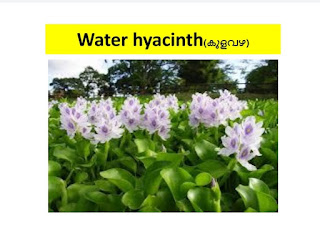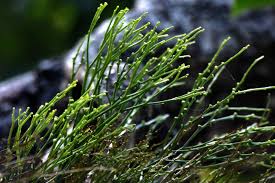UNIT -1
GREEN EARTH
ഹരിതഭൂമി
- മുല്ല Jasmine
- ചെമ്പരത്തി Hibiscus
- മാവ് Mango tree
- പുളി Tamarind
- പാവൽ Bitter gourd
- തൊട്ടാവാടി Mimosa pudica
- മന്ദാരം Mandaram
- തുളസി Basil
- പ്ലാവ് Jackfruit tree
- തേക്ക് Teak
- ആഞ്ഞിലി Aanjili
- തെങ്ങ് Coconut tree
ROOT വേര്
the soil.
വലിച്ചെടുക്കുന്നു.
|
STEM തണ്ട് Carries water and nutriens absorbed by the root to the leaves. വേര് വലിച്ചെടുക്കുന്ന ജലവും പോഷകങ്ങളും ഇലകളിൽ എത്തിക്കുന്നു.
|
LEAF ഇല Prepares the food needed by the plants. സസ്യത്തിനാവശ്യമായ ആഹാരം നിര്മ്മിക്കുന്നു. |
❓Are all plants around us similar ? What are the
differences ?
❓നമുക്ക് ചുറ്റുമുള്ള സസ്യങ്ങൾ ഒരുപോലെയാണോ ? ഏതൊക്കെയാണ്
വ്യത്യാസങ്ങൾ ?
- Size വലുപ്പം ( വലുത് ,ചെറുത്, വണ്ണം കൂടിയതണ്ട്, വണ്ണം കുറഞ്ഞ തണ്ട് )
- Stiffness of stem തണ്ടിൻെറ കാഠിന്യം ( മൃദുവായ തണ്ട് , കാഠിന്യമേറിയ തണ്ട് )
- Lifespan ആയുസ്സ് ( കൂടുതൽ കാലം നിൽക്കുന്നവ, കുറച്ചുകാലം നിൽക്കുന്നവ)
❓ചിത്രത്തിൽ ഏതെല്ലാം സസ്യങ്ങളാണ് നിങ്ങൾ കാണുന്നത് ?
തെറ്റി , ചെമ്പരത്തി, ചീര, ആൽ, നെല്ല്, തെങ്ങ്, റോസ്, മാവ്, തൊട്ടാവടി
❓വലുപ്പത്തിൽ എന്തെല്ലാം വ്യത്യസങ്ങളുണ്ട് ?
❓ഇവ എത്രകാലം നിലനിൽക്കുന്നു ?
❓നിങ്ങളുടെ നിരീക്ഷണങ്ങൾ പട്ടികയിൽ ടിക് (✔ ) ചെയ്യൂ.
❓സ്കൂൾ ജൈവവൈവിധ്യഉദ്യാനത്തിലുള്ള സസ്യങ്ങൾ നിരീക്ഷിച്ച്
പൂര്ത്തിയാക്കുക ?
Plant സസ്യം |
Stem തണ്ട് |
Size വലുപ്പം |
Lifespan നിലനിൽക്കുന്ന കാലം (ആയുസ് ) |
||||||
Soft മൃദു വായത്
|
Hard കാഠിന്യ മുള്ളത്
|
Very hard വളരെ കാഠിന്യ മുള്ളത്
|
Small ചെറുത്
|
Large വലുത്
|
Medi um ഇടത്തരം
|
Mon ths മാസങ്ങൾ
|
Years വര്ഷ ങ്ങൾ
|
Too Many yearsവളരെ അധികം വര്ഷങ്ങൾ
|
|
Spinach ചീര
|
✔ |
|
|
✔ |
|
|
✔ |
|
|
Hibiscus ചെമ്പരത്തി
|
|
✔ |
|
|
|
✔ |
|
✔ |
|
Mango Treeമാവ് |
|
|
✔ |
|
✔ |
|
|
|
✔ |
നെല്ല് |
✔ |
|
✔ |
|
|
✔ |
|
|
|
തെറ്റി |
|
✔ |
|
|
|
✔ |
|
✔ |
|
ആൽ |
|
|
✔ |
|
✔ |
|
|
|
✔ |
റോസ് |
|
✔ |
|
|
|
✔ |
|
✔ |
|
മഷിത്തണ്ട് |
✔ |
|
|
✔ |
|
|
|
|
|
പട്ടിക പരിശോധിച്ചപ്പോൾ എന്തെല്ലാം കാര്യങ്ങളാണ് മനസ്സിലായത് ?
നമുക്കുചുറ്റും കാണുന്ന സസ്യങ്ങൾ വലുപ്പം , തണ്ട് ,നിലനിൽക്കുന്ന കാലം എന്നിവയിൽ വ്യത്യാസമുള്ളവയാണ്.
❓Herbs ഓഷധികൾ
- Very weak and thin stems
- വളരെ ദുര്ബലവും നേര്ത്തതുമായ കാണ്ഡം
- No deep roots ആഴത്തിൽ വേരോട്ടമില്ല
- Short life span
- വളരെ കുറഞ്ഞതും മാസങ്ങൾ മാത്രം നീണ്ടതുമായ ആയുസ്സ്
- Small in size വലുപ്പത്തിൽ ചെറുത്
❓Shrubs കുറ്റിച്ചെടികൾ
- Stiff stems കാഠിന്യമുള്ള തണ്ട്
- Medium size ഇടത്തരം വലുപ്പം
- Life span is 2 to 15 years ഏകദേശം 2 മുതൽ 15വര്ഷം വരെ നീണ്ട ആയുസ്
- Stem is not very thick and strong തണ്ട് വളരെ വലുപ്പത്തിലോ കനത്തിലോ വളരുന്നില്ല
❓Tree മരങ്ങൾ
- Very thick stem വളരെ കാഠിന്യമുള്ള തണ്ട്
- Very large വളരെ വലുപ്പം കൂടിയത്
- Long life span വളരെ അധികം വര്ഷങ്ങൾ നീണ്ട ആയുസ്
- Deep roots ആഴത്തിലുള്ള വേരോട്ടം
Herbs ഓഷധികൾ |
Shrubs കുറ്റിച്ചെടികൾ |
Tree മരങ്ങൾ |
|
|
|
|
|
|
|
|
|
|
|
|
|
|
|
|
|
|
|
|
|
|
|
|
|
|
|
❓Vines വള്ളിച്ചെടികൾ
- Spreads like a creeper
- വള്ളികളായി പടരുന്നു
- Cannot stand up alone
- ഒറ്റക്ക് നിൽക്കാൻ കഴിയില്ല
- Their stem is weak
- തണ്ടിന് ബലം തീരെ കുറവായിരിക്കും.
- They cannot stand erect
- നിവര്ന്നു നിൽക്കാൻ കഴിയില്ല
- Some of them climb on supports
- മറ്റേതെങ്കിലും സസ്യത്തിൻെറ തണ്ടിനെ ചുറ്റിപിണഞ്ഞു നിൽക്കുന്നു.
Vines plants are of two types. Those that spread and grow along the ground, and those that grow upwards by holding on to or by spreading along a support. വള്ളിച്ചെടികൾ രണ്ടുതരമുണ്ട്. നിലത്ത് പടര്ന്നുവളരുന്നവയും താങ്ങിൽ പറ്റിപ്പിടിച്ചോ പടര്ന്നോ മുകളിലേക്കുവളരുന്നവയും.
|
❓Water plants ജലസസ്യങ്ങൾ
Plants that grow in water are water plants.
ജലത്തിൽ വളരുന്ന സസ്യങ്ങളാണ് ജലസസ്യങ്ങൾ.
❓ Find out more water plants and note them down.
കൂടുതൽ ജലസസ്യങ്ങൾ കണ്ടെത്തി എഴുതൂ ?
- Lotus താമര
- Waterlily ( Amber ) ആമ്പൽ
- African moss ആഫ്രിക്കൻ പായൽ
- Water hyacinthകുളവാഴ
- Azolla അസോള
- Black moss കരിംപായൽ
👉 Water plants (AQUATIC PLANTS) ജലസസ്യങ്ങൾ  |
❓What are the features of these plants ?
❓എന്താണ് ഈ സസ്യങ്ങളുടെ പ്രത്യേകതകൾ ?
- They do not decay in water
- വെള്ളത്തിലാണങ്കിലും ചീഞ്ഞുപോകുന്നില്ല.
- They leaves float on water surface
- വെള്ളത്തിൻെറ ഉപരിതലത്തിൽ അതിൻെറ ഇലകൾ പൊങ്ങിക്കിടക്കുന്നു.
- Wax coating on the leaves
- ഇലകളിൽ മെഴുക് ആവരണമുണ്ട്
- Air cavities in leaf and petiole
- തണ്ടിലും ഇലകളിലും വായുഅറകൾ ഉണ്ട്.
- The flower remains erect above the water level
- അവയുടെ പൂക്കൾ വെള്ളത്തിന് മുകളിൽ ഉയര്ന്നു നിൽക്കുന്നു.
തണ്ടിന് കൂടുതൽ നീളമുണ്ട് താമരയ്ക്കും ആമ്പലിനും തണ്ടിലും ഇലയ്ക്കും വായു അറകളുണ്ട് 👇 ഇലയിൽ മെഴുകുപോലുള്ള ആവരണമുണ്ട്.
|
ACTIVITY REPORT പ്രവര്ത്തന റിപ്പോര്ട്ട് )
The change in the plant in seven days
❓Did the leaf or the root sprout first ? ഇലയാണോ വേരാണോ ആദ്യം മുളച്ചുവന്നത് ❓Do you know why plants have roots ? ചെടികൾക്ക് വേര് എന്തിനാണെന്നറിയാമോ ❓How does the root help the plant ? വേര് സസ്യത്തെ എങ്ങനെ സഹായിക്കുന്നു. |
❓Plants that germinate from seed
❓ വിത്ത് മുളച്ച് ഉണ്ടാകുന്ന സസ്യങ്ങൾ
- Papaya (പപ്പായ)
- Soursop (മുള്ളാത്ത
- Water melon (തണ്ണിമത്തൻ)
- Jackfruit tree ( പ്ലാവ് )
- Mango tree (മാവ് )
❓Plants that grow from Roots
- Curry leaf (കറിവേപ്പ് )
- Bread Fruit (ശീമപ്ലാവ് )
- Elephant Yam (ചേന)
- Potato (ഉരുളക്കിഴങ്ങ് )
- Hibiscus (ചെമ്പരത്തി )
- Rose ( റോസ് )
- Brayophyllum ( ഇലമുളച്ചി )
- Queen of night ( Nisagandhi ) ( നിശാഗന്ധി )
|
കൂടുതൽ ഉദാഹരണങ്ങൾ |
|
|||
|
ROOT വേര്
|
STEM കാണ്ഡം തണ്ട്
|
LEAVES ഇല
|
UNDER GROUND STEM ഭൂകാണ്ഡം |
SEED വിത്ത്
|
|
SANDAL WOOD TREE ചന്ദനമരം NEEM വേപ്പ് CURRY LEAF PLANT കറിവേപ്പ് BREAD FRUIT TREE ശീമപ്ലാവ് ANJILI ആഞ്ഞിലി |
TAPIOCA മരിച്ചീനി SUGAR CANE കരിമ്പ് HIBISCUS ചെമ്പരത്തി ROSE റോസ PEPPER കുരുമുളക് GLYRICIDIA (ശീമക്കൊന്ന) |
BRYOPHYLLUM ഇലമുളച്ചി QUEEN OF NIGHT (NISAGANDHI) നിശാഗന്ധി BIGONIA ബിഗോണിയ NILAPANA നിലപ്പന PEPEROMIA പെപ്പറോമിയ
|
GINGER ഇഞ്ചി YAM കാച്ചിൽ POTATO ഉരുള ക്കിഴങ്ങ് PLANTAIN വാഴ ONION ഉള്ളി COLOCASIA ചേമ്പ് ELEPHANT FOOT YAM ചേന TURMERIC മഞ്ഞൾ |
RICE നെല്ല് PEA പയർ WHEAT ഗോതമ്പ് LADY ‘S FINGER വെണ്ട CUCUMBER വെള്ളരി PUMPKIN മത്തൻ CHILLI മുളക് COCONUT തേങ്ങ
|
- Plants need water for survival
- The roots of plants draw water from the soil.
- The drawn water is transported to different parts of the plant by the stem.
- The water drawn by the root reaches the leaves through the stem.
- The plant in the third test tube withered becouse plants
The leaves known as kitchen of plants. Plants make their food in leaves. It is used for their growth. The rest of the food is stored in different parts of the plant. It is used by other organisms as food ഇലകളെ സസ്യങ്ങളുടെ അടുക്കള എന്നറിയപ്പെടുന്നു. ചെടികൾ അവയ്ക്ക് ആവശ്യമായ ആഹാരം നിര്മ്മിക്കുന്നത് ഇലകളിലാണ്. ഇത് അവയുടെ വളര്ച്ചക്കായി ഉപയോഗിക്കുന്നു. ബാക്കി വരുന്ന ആഹാരം ചെടി അതിൻെറ വിവിധ ഭാഗങ്ങളിലായി കരുതിവെയ്ക്കുന്നു. അത് മറ്റ് ജീവജാലങ്ങൾ ഭക്ഷണമായി ഉപയോഗിക്കുന്നു.
|
VARIETIES OF LEAVES ഇലകളുടെ വൈവിധ്യം
No. നമ്പര് |
Name of the plant സസ്യം
|
Shape of the plant ആകൃതി |
Do leaves smell മണം |
Colour of the leaves നിറം |
1
|
Thumba തുമ്പ |
Long and tapering നീണ്ടുകൂര്ത്തത് |
Yes മണമുണ്ട് |
Green പച്ച |
2
|
Mango മാവ് |
Long and taperingനീണ്ടുകൂര്ത്തത്
|
Yes മണമുണ്ട്
|
Green പച്ച
|
3 |
Money plant മണി പ്ലാൻറ് |
Cordate വട്ടത്തിൽ പരന്നത് |
No മണമില്ല |
Green Green വെള്ളയും പച്ചയും |
4
|
Aloe Vera കറ്റാര്വാഴ |
Triangular with serrated edges അരികുകളുള്ള ത്രികോണാകൃതി |
No മണമില്ല |
Green പച്ച |
5
|
Orchid ഓര്ക്കിഡ് |
Ensiform നീണ്ടുകൂര്ത്തത് |
No മണമില്ല |
Green പച്ച |
- Shape (ആകൃതി)
- Smell (മണം)
- Colour (നിറം )
- The bee gets honey
- തേനീച്ചയ്ക്ക് തേൻ ലഭിക്കുന്നു.
- Some flowers turn into seeds
- ചില പൂക്കളൾ വിത്തായി മാറുന്നു
- New plant arises from flowers
- പൂക്കളിൽ നിന്നും പുതിയ ചെടി ഉണ്ടാകുന്നു.
- Flowers are decorative
- പൂക്കൾ അലങ്കാരമാണ്
- Spread fragrance
- ഗന്ധം (മണം ) പരത്തിന്നു
- Manufactures different types of perfumes.
- വിവിധ തരം പെര്ഫ്യൂമുകൾ നിര്മ്മിക്കുന്നു.
- Some flowers are used for medicine
- മരുന്നിനായി ചില പൂക്കൾ ഉപയോഗിക്കിന്നു
- Used for food
- ഭക്ഷണത്തിനായി ഉപയോഗിക്കുന്നു.
 | |||
| FERN (പന്നലുകൾ) |
 |
| HORSETAIL( ഹോഴ്സ്ടെയിൽസ് ) |
 |
| CLUB MOSS( ക്ലബ് മോസസ് ) |
 |
| WHISK FERN ( വിസ്ക് ഫെര്ണുകൾ ) |
- Ferns (പന്നലുകൾ)
- Horsetails ( ഹോഴ്സ്ടെയിൽസ് )
- Club mosses ( ക്ലബ് മോസസ് )
- Whisk ferns ( വിസ്ക് ഫെര്ണുകൾ )
- Liverworts ( ലിവര്വോര്ട്ട്സ് )
- Mosses ( പായലുകൾ )
- Hornworts ( ഹോൺവോര്ട്ട്സ് )
- Coniferes ( കോണിഫറുകൾ )
- Cycards ( സൈക്കാഡുകൾ )
- Ginkgo ( ജിങ്കോ )
Cactus plant (കള്ളിമുൾച്ചെടി ) Cactus
plant are plants found mainly in deserts. They have the unique
characteristic of being able to survive without water for long periods
of time by collecting available water in their stems. പ്രധാനമായും
മരുഭൂമിയിൽ കാണപ്പെടുന്ന സസ്യങ്ങളാണ് കള്ളിച്ചെടി എന്നറിയപ്പെടുന്ന
കള്ളിമുൾച്ചെടികൾ. ലഭ്യയമാകുന്ന ജലം കാണ്ഡത്തിൽ ശേഖരിച്ച് ഏറെക്കാലം ജലം
ഇല്ലാതെ ജീവിക്കാൻ കഴിയുന്ന സവിശേഷ സ്വഭാവം ഇവയ്ക്കുണ്ട്.
|
- Plant parts are used as food.
- സസ്യ ഭാഗങ്ങൾ ഭക്ഷണമായി ഉപയോഗിക്കുന്നു.
- Plants are home to variety of organisms.
- വ്യത്യസ്തമാര്ന്ന ജീവികളുടെ വാസസ്ഥലമാണ് സസ്യങ്ങൾ.
- Shade is provided by plants.
- തണൽ നൽകുന്നത് സസ്യങ്ങളാണ്.
- Plants make the earth green.
- ഭൂമിക്ക് പച്ചപ്പ് നൽകുന്നത് സസ്യങ്ങളാണ് .
- Helps to get pure air.
- ശുദ്ധ വായു ലഭിക്കുന്നതിന് സഹായിക്കുന്നു.
- Many plan parts are used medicinally.
- പല സസ്യഭാഗങ്ങളും മരുന്നായി ഉപയോഗിക്കുന്നു.
- Helps prevent soil erosion.
- മണ്ണൊലിപ്പ് തടയുന്നത് തടയുന്നു.


































No comments:
Post a Comment